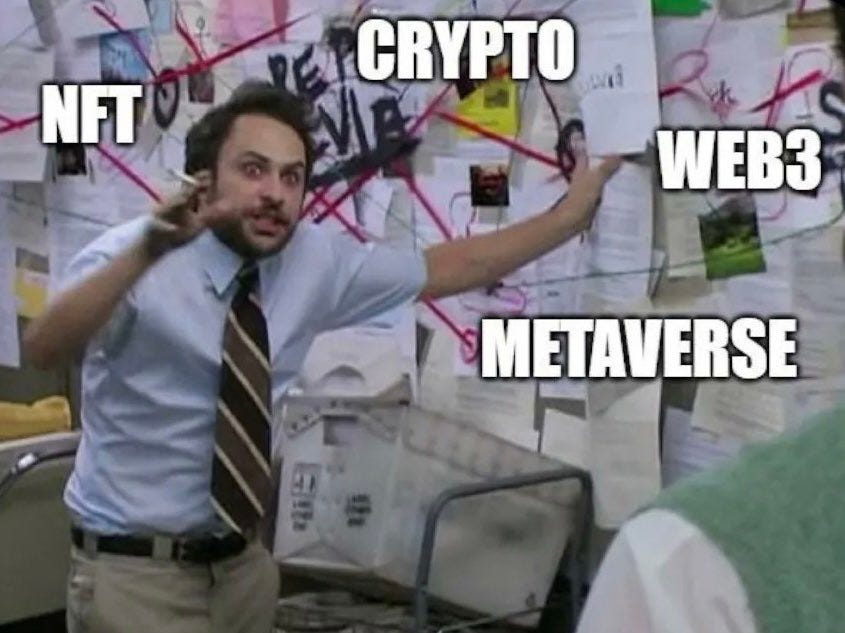Wtf is Web3? A Beginner’s Simple Guide
 Alex Omenye
Alex Omenye
What’s this Web3 that everyone has been talking about, and how can I get into it? Help me!
What exactly is Web3?
Web3 is the latest version of the internet, first introduced in 2014 by Gavin Wood, co-founder of Ethereum, a blockchain-powdered platform.
I coded the first functional Ethereum client in January 2014 released as “PoC-1” (i.e. the first proof of concept) and co-founded the project. Shortly after, I authored the Yellow Paper, the first formal specification of any blockchain protocol and one of the key ways Ethereum distinguished itself from other blockchain-based systems.
It envisions a decentralized internet that reduces the dominance of major big tech companies like Meta, Amazon, and Google, which currently control a chunk of Web 2.0.

In this new version of the internet, users would have greater control over their data rather than it being collected and monetized by companies. The goal is to create a more interactive online experience with enhanced privacy and ownership of digital information. An example is bumping in ads tailored to your interests, and this is because have companies tracked your online activity data and sold that data to advertisers. Web3 is more like a cop against this, giving users autonomy over their data and online interactions.
Why Web3?
Many of Web3’s benefits stem from its decentralized nature. In Web 2.0, people must log into social networks to access, share, or interact with content, which in other words means control in participation and interactions. They can remove users (Remember Kanye West, Donald Trump), restrict access, or dictate engagement rules. Web3 in contrast, empowers communities to self-govern content and participation.
Here are some key advantages of a decentralized internet, although not limited to these:
Interaction: Web3 fosters greater engagement by allowing users to interact more freely with content and each other, surpassing the experience offered by Web 2.0 and 1.0.
Ownership: Users are not just consumers but stakeholders in the community, earning incentives for participation rather than exchanging personal data for access.
Permissions: Everyone on the network has equal access to its data and services, removing centralized gatekeepers.
Privacy: User identities are linked to digital wallets, making online activities transparent while allowing individuals to remain anonymous.
Speed: Blockchain technology, combined with AI, machine learning, and smart contracts, delivers more relevant information to users faster and more efficiently.
Ok, how do I vibe with Web3?
Web3 is not just for crypto nerds; there’s room for EVERYONE. Whether you wanna work in Web3 or just use the apps, here’s how to get started:

1. Explore Career Paths
Web3 jobs span multiple industries and skill levels, making it accessible to a wide range of professionals. Some key career categories include: engineering (Blockchain developers, smart contract engineers), Crypto & DeFi (Analysts, traders, liquidity managers), Product & Design (UX/UI designers, product managers) Marketing, Community & Operations (Marketers, community builders, creators and business development specialists) Legal & Compliance (regulatory analysts, compliance officers and lawyers)
2. Develop Essential Skills
The skills required for Web3 careers vary by role. For example: a front-end Web3 developer should have experience with UX/UI design and programming languages such as JavaScript, Solidity, and Rust and a Web3 marketer should be skilled in content marketing, social media engagement, community building, and brand strategy.
Identifying the right skills for your desired role and developing expertise in those areas is key to landing a Web3 job.
3. Join Communities
Networking is the cheat code. If you’re not in Web3 groups, wyd? In Web3, networking and community involvement are essential for securing job opportunities. Many companies and decentralized autonomous organizations (DAOs) prefer to hire individuals who actively contribute to their ecosystems. To enhance your chances:
Join Web3 communities on platforms like Discord, Telegram, and Twitter.
Engage in discussions, attend industry events, and participate in DAOs or open-source projects.
Contribute to hackathons and decentralized initiatives to build credibility.
Since many Web3 jobs are filled through community connections rather than traditional job applications, active engagement can significantly boost your chances of success.

4. Apply for Jobs
When you’re ready to apply, explore opportunities through:
Web3 job boards
Social media platforms (LinkedIn, Twitter)
Discord and Telegram channels
Company career pages
Internships and entry-level roles
Proactively reaching out and engaging with hiring managers or project leads can also help you land a position. Many roles get filled via community connections, so stay active and slide into DMs (professionally, ofc).
Good luck with that!
5. Build Your Brand
Wanna stand out? Be loud about your Web3 journey. Demonstrating your knowledge and skills publicly can help attract job opportunities. Consider starting a blog or posting on Twitter to share your Web3 learning journey, regularly posting updates about new skills, projects, or insights. Don’t sleep on engaging with Web3 professionals online to learn from their experiences and build valuable connections.
Stuff I consumed to produce this:
1. What Is Web3? By Built-in. S/O to Edoardo Romani for this flawlessly written article. I loved it. For everyone looking to make an entry into Web3, the foundational knowledge in this article is helpful.
2. How to Onboard Into Web3: Step-By-Step Guide: This article by Arounda was instrumental in my research on an entry into Web3
3. How to Get a Web3 Job: Quite a semi-long read on how to get into a Web3 Job. It offered insights on how to Web3, and eventually land a job.
4. What is Web3? The Decentralized Internet of the Future Explained: I loved FreeCodeCamp’s article on Web3 because it was historical in a bit. It began with the evolution from Web1 to Web3.
Subscribe to my newsletter
Read articles from Alex Omenye directly inside your inbox. Subscribe to the newsletter, and don't miss out.
Written by

Alex Omenye
Alex Omenye
Decoding Web3 one block at a time. Writing about crypto, and the decentralized future—so you don’t have to read a 50-page whitepaper. 🚀